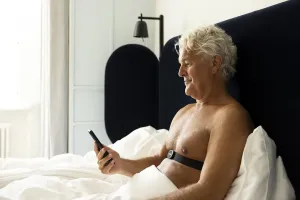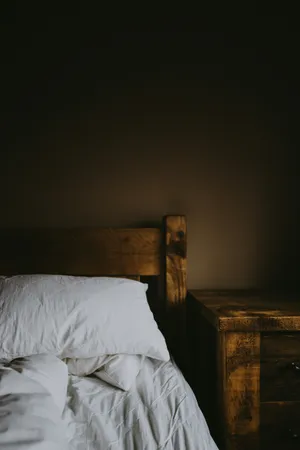New Frontiers in Ambulatory Sleep Research: Scientific Perspectives on HRV-Based Sleep Staging
Pavlos Topalidis, PhD | 20.05.2025

Abstract
Ambulatory sleep monitoring is entering a transformative phase. Advances in heart rate variability (HRV)-based sleep staging now allow for accurate, cost-efficient, and ecologically valid sleep measurement beyond the confines of sleep laboratories. This article outlines the methodological foundation and potential research applications of a validated, wearable sleep staging system based on inter-beat interval (IBI) analysis. The aim is to stimulate discussion and provide inspiration for researchers in psychology, neuroscience, medicine, and public health to design novel studies using this accessible technology. Rather than promoting a specific product, the focus lies on expanding the methodological toolbox for high-quality sleep research in real-world environments.
1. Introduction: From Laboratory to Everyday Life
Polysomnography (PSG) remains the clinical gold standard for sleep assessment. While highly accurate, PSG is expensive, logistically demanding, and ecologically artificial. These limitations become particularly pronounced in longitudinal designs, hard-to-reach populations, or large-scale studies.
Recent advances in wearable technology and machine learning now enable sleep staging using HRV data derived from inter-beat intervals (IBIs). This approach does not require EEG or professional technician oversight and allows for continuous, scalable, and non-invasive measurement in naturalistic environments.
Our group at the University of Salzburg has contributed to this development by validating machine learning models that classify sleep stages based solely on HRV dynamics, yielding encouraging levels of agreement with PSG-based scoring (Topalidis et al., 2023a, 2023b).
2. Methodology: Validated HRV-Based Sleep Staging
The sleep staging methodology relies on commercially available and accurate wearable sensors (e.g., POLAR H10 chest straps or Verity Sense optical armbands) to record high-resolution inter-beat intervals. These data streams are then processed using machine learning algorithms to classify each 30-second epoch into one of four sleep stages: wake, light sleep, deep sleep, or REM sleep.
In validation studies, our models achieved κ-values up to 0.72 against expert PSG scoring, demonstrating substantial agreement in classifying sleep stages—including REM and deep sleep—based on HRV data (Topalidis et al., 2023a. 2023b). Unlike traditional actigraphy, which is limited to binary sleep-wake detection, our approach provides detailed staging with low participant burden and high temporal resolution. This positions it as a methodological bridge between full polysomnography (PSG) and field-ready tools, combining scalability with enhanced physiological insight.
3. Expanding the Design Space: Applications in Sleep Research
This methodological advance unlocks study designs that were previously impractical due to technical, financial, or logistical constraints.
3.1 Longitudinal Monitoring with High Temporal Resolution
Sleep architecture is not static; it fluctuates in response to life events, stress, hormonal cycles, medication, and environmental factors. HRV-based staging allows researchers to track these changes over weeks or months with minimal burden.
Potential research questions:
- How does slow-wave sleep evolve across consecutive night shifts including weekends where users usually catch up on sleep (social jetlag)?
- What are the effects of SSRIs on REM duration over time?
- Can chronic stress or burnout be detected through specific changes in one or more sleep variables (e.g., cumulative changes in sleep efficiency, number of stage shifts and REM sleep proportions)?
3.2 Ecological Studies in Vulnerable Populations
Sleep labs are often inaccessible to groups with psychological disorders, trauma histories, disabilities, or socioeconomic barriers. A wearable-based approach enables in-home, stigma-free, and unobtrusive sleep monitoring—even in remote, high-risk, or mobile populations.
Possible research settings:
- Sleep disturbances in post-traumatic stress disorder (PTSD)
- Evaluation of digital interventions for sleep in displaced or refugee populations
- Sleep behavior among elderly individuals with mild cognitive impairment
3.3 Ambulatory Intervention Studies (CBT-I, Neurology, Nutrition)
HRV-based monitoring can be paired with digital interventions, allowing researchers to evaluate the effects of behavioral or pharmacological treatments on sleep in real time., that is day-by-day rather than just pre to post intervention (with a single snapshot=night).
Example designs:
- Randomized controlled trials of app-based cognitive behavioral therapy for insomnia (CBT-I) over 8 weeks of intervention
- Longitudinal tracking of hypersomnolence and “sleep attack” frequency over 100 days to assess individual treatment response and temporal patterns in the sleeping beauty phenomenon.
- Interaction of daily meal timing and sleep onset latency or subsequent sleep quality in metabolic research
3.4 Subjective–Objective Concordance Studies
The ability to capture both objective sleep metrics and subjective assessments (e.g., diaries, ecological momentary assessments, PROMs) allows researchers to examine discrepancies between perceived and physiological sleep. This is particularly relevant in clinical populations such as insomnia, anxiety, or depression.
Potential inquiries:
- Which sleep parameters best predict subjective sleep quality?
- How do mood disorders affect the concordance between sleep perception and physiology?
- How do daily behaviors, stressors, or lifestyle factors captured via Ecological Momentary Assessment (EMA) relate to changes in objective sleep parameters (and vice versa)?
4. Methodological Considerations and Limitations
Despite its promise, HRV-based sleep staging should be considered a complementary method—not a replacement for PSG. Researchers must consider the following:
- Validation data is often based on healthy adults; caution is warranted in extrapolation to children, elderly, or clinical groups.
- Motion artifacts, arrhythmias, and sensor displacement can affect signal quality.
- Is the chosen wearable in a good position (and worn correctly) to capture highly accurate data in the millisecond range (e.g, close to the heart may be better than on the wrist)
- Is the sensor itself of highest technical quality to provide reliable data in the first place
Proper signal preprocessing, artifact handling, and adherence protocols are key to data quality, especially when recording outside the controlled laboratory setting. Studies must report thresholds, dropout rates, and imputation strategies to ensure reproducibility.
5. Opportunities for Large-Scale and Interdisciplinary Research
By lowering the financial and logistical threshold for objective sleep data collection, HRV-based staging invites new stakeholders into the field of sleep research:
Dimension
Sleep Lab (PSG)
HRV-Based Wearables
Cost per participant
High (equipment, staff)
Low (commercial sensors, automated)
Setting
Artificial (lab)
Natural (home, travel, field)
Scalability
Low (few beds)
High (hundreds of parallel users)
Populations
Selective
Inclusive (clinical, rural, mobile)
Study Duration
1–3 nights typically
Weeks to months
This enables, for example:
- Nationwide as well as inter-cultural epidemiological studies
- Sleep-tracking modules in digital health trials
- Early detection of neuropsychiatric disorders through sleep changes
- Personalized sleep coaching based on objective metrics
6. Conclusion: From Technology to Insight
The integration of HRV-based sleep staging into research practice marks a shift from invasive, short-term sleep studies to scalable, ecologically valid investigations. It opens new frontiers in behavioral science, chronobiology, sleep medicine, and digital health - especially in settings where PSG is impractical or infeasible.
As researchers, we are now equipped to study sleep not just in ideal laboratory conditions, but in real life - where it truly matters.
Sources:
- Topalidis, P., Baron, S., Heib, D. P., Eigl, E. S., Hinterberger, A., & Schabus, M. (2023). From pulses to sleep stages: towards optimized sleep classification using heart-rate variability. Sensors, 23(22), 9077. https://doi.org/10.3390/s23229077
- Topalidis, P., Heib, D. P., Baron, S., Eigl, E. S., Hinterberger, A., & Schabus, M. (2023). The virtual sleep lab—a novel method for accurate four-class sleep staging using heart-rate variability from low-cost wearables. Sensors, 23(5), 2390. https://doi.org/10.3390/s23052390
- Hachenberger, J., Baron, S., Schabus, M., & Lemola, S. (2025). The role of objective sleep duration, continuity, and architecture for subjective sleep perception: Findings from an intensive longitudinal study. Sleep Medicine, 129, 167–174. https://doi.org/10.1016/j.sleep.2025.02.040




